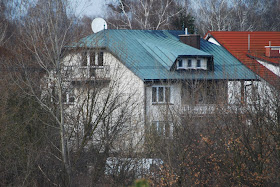What about my existing 80-400mm lens? Still useful? A question I'll answer in this blog...
The 80-400mm zoom is a magnificent and huge piece of glass designed for FX sensor (full-frame) Nikons. It's a bit dated now, originally appearing in 2001, and has been replaced by a newer 80-400mm optic that's faster focusing (the old one's autofocus is slow) though heavier.
Now, the D3200 being a budget Nikon DSLR, does not have an internal lens auto-focusing motor, so the 80-400mm is incompatible with it. The 55-300mm lens doesn't need an internal AF motor.
I bought the 55-300mm on the premise that the D3200, with its 24 million pixel sensor, will allow a digital zoom that's bigger than the image you'll get from the D80, with its 12 million pixel sensor. The saving in weight was my main consideration. The D80/80-400mm combo weighs over 2.1kg (with strap, filter and hood), while the D3200/55-300mm combo weighs over 1.1kg (with strap, filter and hood). The difference is the equivalent weight of two full half-litre beer cans. Having that round one's neck for any length of time is noticeable.
Below: the D80/80-400mm is left, the D3200/55-300mm is right. Look at the massive size difference - and this is with both lenses zoomed right back to their shortest length.
That's some difference! Now, let's compare the images the two lenses produce. Can the smaller lens really give better performance on a larger sensor than the bigger lens on a smaller sensor?
Below: shot from my bedroom window, unPhotoshopped images from the two combos. Both images shot at 1/200sec at f5.6. Both cameras set at 100 ISO, image optimised at 'vivid'. Both JPEG images compressed to 57% of original file size.
 |
| D3200 with 55-300mm lens zoomed to 300mm |
 |
| D80 with 80-400mm lens zoomed to 400mm |
 |
| D3200 with 55-300mm lens zoomed to 300mm, crop from 100% enlargement |
 |
| D80 with 80-400mm lens zoomed to 400mm, crop from 100% enlargement |
So. For walking and cycling, the new 55-300mm is a winner. Almost a kilo lighter than the old combo, it delivers a comparable degree of zoom when magnified. What will I do with the old combo then? Probably time to sell. Along with my old film Leica rangefinders (M2, M3, M6).
This time last year:
Warsaw's grand Central Station
This time three years ago:
Making sense of Polish politics

Michal,
ReplyDeleteVery interesting and useful - but can you give a comment on the difference between having a single 18-200 or the 55-300 plus 18-55.
I'd be interested to hear why you did not replace the 18-200?
@ Janek
ReplyDeleteI've still got a broken 18-200, which one day I'll get fixed (if economically sensible to do so). The extra reach to 300mm is one reason why I went for this lens. Wildlife and aviation. There is now an 18-300mm, but it weighs a ton. I'm now taking three lenses with me most of the time, covering 10-300mm (15-450mm on full-frame).
Thanks for this.
ReplyDeleteNow need to decide what would work best for me!
This is cool!
ReplyDeleteHi Michael, I've been taking wildlife photos with a bridge camera at 18x optical zoom but obviously the quality is far inferior to that of a DSLR Camera (terrible in fact).
ReplyDeleteI am toying with the idea of buying the Nikon D3200 and the Nikkor 55-300mm VR lens. Am I right in thinking this will effectively give me 450mm (due to cropping) - I am a DSLR newbie!
I have been advised by numerous people a 400mm lens is a must for wildlife (small mammals, birds etc) shots with a DSLR. Thanks for any help you can offer.
The 80-400mm Nikkor doesn't work with the D3200; you'll have to invest in the top-of-the-DX-range D7100 to get a body with a focus motor. So - if your budget only stretches to a D3200 or D5300 body - go for the 55-300mm lens.
ReplyDeleteIf you can afford the D7100, the 80-400mm lens with the DX cropping gives you in effect the equivalent of a 600mm lens. NICE! Very good for wildlife - BUT... make sure it's the latest 80-400mm Nikkor, not the older one (which I have - and now no longer use). The autofocus is s-l-o-w.
well if only i seen this earlier would have saved some trouble
ReplyDelete